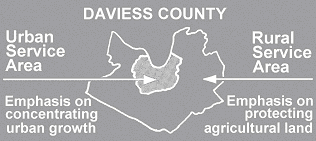Rapid Rural Subdivision
An excerpt from the Comprehensive Plan, Section 430 Land Development Policies
Also see Kentucky’s Smart Growth website.
The pace and amount of rural residential development [in Daviess County] is exceeding that recommended by previously adopted land use goals and objectives. This has resulted in increased conflicts with coal mining, growth in demand for dispersed urban services, and proliferation of point sources of water pollution in the form of private septic tanks.

In the Rural Service Area (RSA), one-acre lots have been traditional. To further encourage the concentration of rural development in existing developed areas, a regulatory bonus was provided to allow half-acre lots in and around the twenty established Rural Communities. In 2004, the half-acre minimum size in rural communities not served by sanitary sewer was increased to a minimum of three-quarter-acre as a result of recommendations of the Green River Health Department for adequate septic system installation.
There has been more development in the RSA than was anticipated and it has accelerated in the first five years of this century.
Between 1980 and 2005, 61% of the increase in lots was in the USA. But, these lots only used 25% of the acres developed for residential lots. Conversely, 39% of the lot increase was in the RSA , requiring 75% of the acres developed for residential lots.
While current policies have certainly discouraged or eliminated some lot divisions, there is still ample opportunity for lots to occur along existing roads meeting the current regulations, and the past six years have seen significant lot creation in the rural service area.
| AVERAGE LOT SIZE (ACRES) | |||
| Average size of new lots created | |||
| Rural Zones | Urban Zones | Total | |
| DC | 3.1 | 0.6 | 1.4 |
| USA | 6.3 | 0.5 | 0.6 |
| UBA | 6.2 | 0.5 | 0.5 |
| RSA | 3.0 | 1.4 | 2.6 |
| UC | — | — | — |
| UB | — | 0.4 | 0.4 |
| UG | 7.4 | 0.5 | 0.5 |
| UF | 6.6 | 0.5 | 0.8 |
| RPu | 3.1 | 0.4 | 0.9 |
| RPr | 3.1 | 1.1 | 2.2 |
| RM | 2.9 | 2.1 | 2.8 |
| Rural Zones = A-R. Urban Zones = A-U, Res, MHP. | |||
Subdivisions Along Existing Road Frontage
What are the implications if this trend in rural development continues in the future? Because RSA subdivisions are loosely permitted along existing road frontage, the potential exists for many more lots than exist now. Projections for residential uses contained in Section 420 show this potential when using the residential trend projection. Population density has changed from 260 acres per thousand persons in 1999 to 288 acres per thousand persons in 2005, just six years, and despite the fact that the population has not shown the same rate of growth. This is mainly due to the increasing use of agriculturally zoned property being converted to residential lots along existing county road frontage. If this trend continues at the current rate, it is projected that an additional 11,000 acres of residential use will be needed by 2030. If the rate accelerates, even more acres may be converted to residential use.
“Agricultural Divisions”
Since the 1998 changes in fire protection requirements, rural farms that do not have adequate-sized waterlines for fire hydrants have continued to be divided as so-called “agricultural divisions,” under a long-standing policy of the commission. This policy allows the division of a farm into tracts a minimum of 10 acres in size, so long as each tract has frontage of at least 50 feet along an existing public road. These plats are deemed to be for “agricultural use” as defined by KRS 100 and, therefore, are not required to comply with subdivision regulations. The planning commission has begun to monitor the number of tracts created in this manner. The planning commission and the Daviess County Property Valuation Administrator consider these tracts to be “farms” rather than “lots.” If the observed trend to divide farms into 10-acre “mini-farms” continues over time, it could significantly decrease the amount of economically viable farmland in Daviess County.
Environmental Impact
The two most significant environmental implications of rapid rural residential development and “agricultural divisions” are the loss of farmland and the increasing use of septic tanks. In recent years, numerous farms have been totally subdivided and sold at auction. This puts pressure on individual farm owners to consider subdivision as a means of income unrelated
to farming. Once land is subdivided into small tracts and sold to various individuals, its agricultural potential is lost or at least significantly diminished.
The use of septic tanks in the RSA has several implications. Many houses constructed on the one-half acre lots previously allowed in rural growth areas must use pressurized septic systems costing thousands of dollars more than conventional systems. The Daviess County Health Department believes minimum lot size should be at least 3/4 of an acre to allow conventional systems. In 2004, the minimum lot size for lots being served by septic systems was increased to 3/4 acres.
Proliferation of septic systems — conventional or otherwise — throughout the rural area could lead to serious water quality problems. If and when clear evidence of this is found, there may be no easy (inexpensive) way to rectify these problems. To the extent that Daviess County’s population growth occurs in rural areas where there are no sewers or plans for sewers, this forestalls development in the Urban Service Area, wastes the capacity of current sanitary sewer expansions, and delays planned sewer expansions to currently un-served urban areas. Thus, septic problems in existing subdivisions within the USA could remain unsolved even longer.
Urban Service Availability
What demand could rapid rural residential development eventually place on local government services? As the rural area becomes more urbanized, demand grows for services that people expect to have in residential areas: road improvements, enhanced police and fire protection, schools, parks, etc. But the cost per home for providing these services increases dramatically, due to low population densities scattered over large areas. Thus, service expansions to rural areas tend to be marginal at best. When the development that does occur is located in rural areas instead of near existing built-up areas, planned urban service expansions cannot be made efficiently, and result in piecemeal solutions.
Water supply is another example. In an attempt to meet rural demand for a reliable and pure supply of water, water lines have been extended over wide areas of the county. County government has subsidized many of these extensions. While domestic water is provided, many of these lines do not have the pressure necessary for effective fire fighting, thus home insurance rates are much higher in rural areas.
Continued rapid rural development would only exacerbate fire protection deficiencies, and would likely lead to other service deficiencies and inefficiencies for both developing rural areas and existing urban areas.
Land Use Compatibility
Extensive rural residential development would increase conflicts between residential commuter traffic and the movement of farm vehicles, and could lead to pressures for spot commercial activities in conflict with objectives for larger, planned business centers. But the most controversial issue has been the conflict between rural residences and coal mining activities.
Residential Conflicts with Coal Mining
In the mid-1980s, rural residents began to demand better protection from incompatible impacts of mining: dust, noise, nighttime operation, truck traffic, etc. Existing rural residential areas have been accommodated without significantly impinging on mining as a primary use in the rural area. Active mining of zoned land has declined significantly from its level in the 1980s. However, if rapid rural residential development continues, and coal mining resumes, neighborhood objections to mining could become widespread in the rural area, severely limiting the extraction of this resource, in conflict with adopted goals for the rural area.
Alternative Policies: Rural Residential, Coal Mining
The current issues and future problems related to rural residential development arise from the pace of this development. We seek to provide for rural residences through our goals and objectives, but only in such a manner that the character of rural areas will not significantly change from primarily agricultural and resource related. We also seek to avoid long-term use of ever more septic tanks that would pollute our ground water and demand for costly urban services spread over wide areas of the county.
